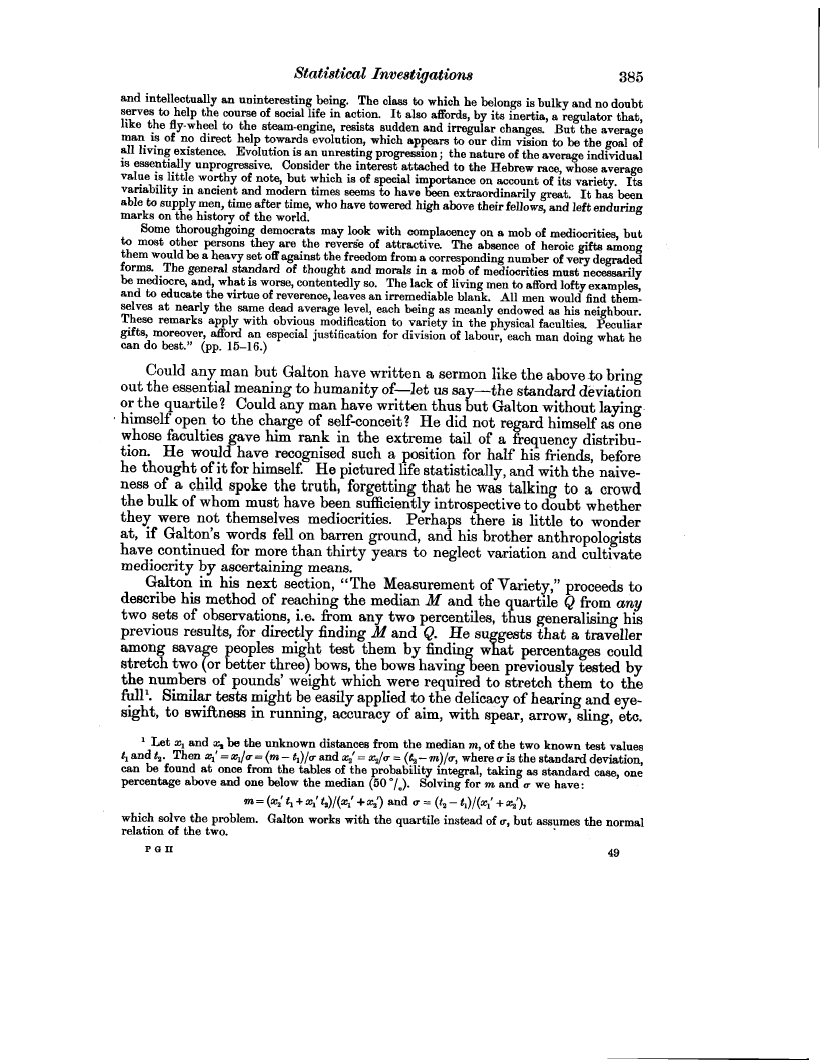Statistical Investigations 385
and intellectually an uninteresting being. The class to which he belongs is bulky and no doubt serves to help the course of social life in action. It also affords, by its inertia, a regulator that, like the fly-wheel to the steam-engine, resists sudden and irregular changes. But the average man is of no direct help towards evolution, which appears to our dim vision to be the goal of all living existence. Evolution is an unresting progression; the nature of the average individual is essentially unprogressive. Consider the interest attached to the Hebrew race, whose average value is little worthy of note, but which is of special importance on account of its variety. Its variability in ancient and modern times seems to have been extraordinarily great. It has been able to supply men, time after time, who have towered high above their fellows, and left enduring marks on the history of the world.
Some thoroughgoing democrats may look with complacency on a mob of mediocrities, but to most other persons they are the reverse of attractive. The absence of heroic gifts among them would be a heavy set off against the freedom from a corresponding number of very degraded forms. The general standard of thought and morals in a mob of mediocrities must necessarily be mediocre, and, what is worse, contentedly so. The lack of living men to afford lofty examples, and to educate the virtue of reverence, leaves an irremediable blank. All men would find themselves at nearly the same dead average level, each being as meanly endowed as his neighbour. These remarks apply with obvious modification to variety in the physical faculties. Peculiar gifts, moreover, afford an especial justification for division of labour, each man doing what he can do best." (pp. 15-16.)
Could any man but Galton have written a sermon like the above-to bring out the essential meaning to humanity of-let us say-the standard deviation or the quartile? Could any man have written thus but Galton without layinghimself open to the charge of self-conceit? He did not regard himself as one whose faculties gave him rank in the extreme tail of a frequency distribution. He would have recognised such a position for half his friends, before he thought of it for himself. He pictured life statistically, and with the naiveness of a child spoke the truth, forgetting that he was talking to a crowd the bulk of whom must have been sufficiently introspective to doubt whether they were not themselves mediocrities. Perhaps there is little to wonder at, if Galton's words fell on barren ground, and his brother anthropologists have continued for more than thirty years to neglect variation and cultivate mediocrity by ascertaining means.
Galton in his next section, "The Measurement of Variety," proceeds to describe his method of reaching the median M and the quartile Q from any two sets of observations, i.e. from any two percentiles, thus generalising his previous results, for directly finding M and Q. He suggests that a traveller among savage peoples might test them by finding what percentages could stretch two (or better three) bows, the bows having been previously tested by the numbers of pounds' weight which were required to stretch them to the full'. Similar tests might be easily applied to the delicacy of hearing and eyesight, to swiftness in running, accuracy of aim, with spear, arrow, sling, etc.
1 Let x, and xQ be the unknown distances from the median m, of the two known test values t, and tQ. Then x,'= x,/a- = (m - t,)/a- and x,'= xQw = (4- m)/o., where o- is the standard deviation, can be found at once from the tables of the probability integral, taking as standard case, one percentage above and one below the median (50'/.). Solving for m and a- we have:
m = (x2 t, + x; Q/(4 + x,) and a = (t4 - t,)/(xi + x~'),
which solve the problem. Galton works with the quartile instead of a-, but assumes the normal relation of the two.
roil 49

